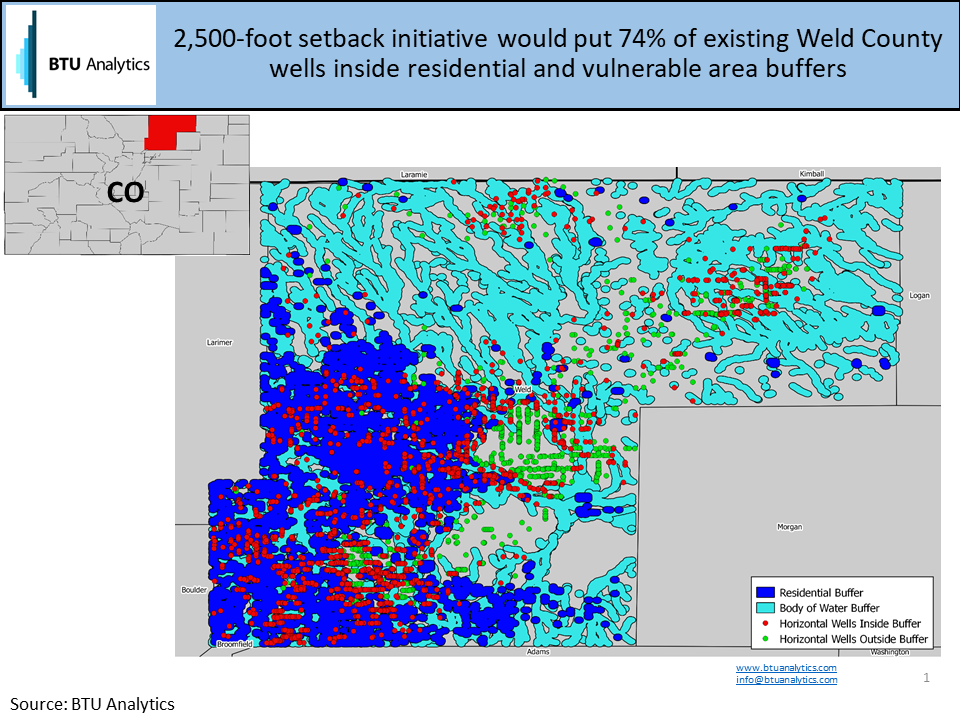Over the past few years as the importance of shale hydrocarbons in the US has risen, a number of state and local governments have attempted to increase their involvement in oversight of US hydrocarbon development. Examples across the US include the denial of permits in New York state, tighter regulations on water injection wells in Oklahoma, and ongoing legal battles on hydraulic fracking in Colorado. Today we’ll analyze the impact of a newer threat on the DJ Basin in the form of expanded well setback, Colorado Initiative #97.
Initiative #97 aims to designate a 2,500-foot buffer zone off limits to new oil and gas development around any occupied structure (mostly residential areas) or vulnerable areas (playgrounds, public parks, and basically any body of water). You might recall that we analyzed another Colorado initiative back in 2016, and though the initiative ultimately failed, any successful legislation change could have a profound impact on the oil and gas industry in Colorado. Based on a recent study by the Colorado Oil and Gas Conservation Commission, the buffer created by the initiative would leave 54% of Colorado’s total land surface off limits to new oil and gas development, including 78% of the land in Weld County which sits in the heart of the DJ Basin.
The map below shows the area in Weld County that would be off limits for oil and gas development going forward based on a 2,500-foot buffer as well as all horizontal wells that have been completed since 2006. Red dots signal wells that could not be drilled in the future if the initiative were to ultimately succeed, whereas green wells would still be situated in territory open to future oil and gas development. These ‘off-limits’ wells constitute 74% of all horizontal wells completed in Weld County since 2006.

The picture doesn’t get much better when looking at the economics of remaining land able to be developed if the 2,500-foot buffer were put in place. The map below shows BTU Analytics’ economic grids featured in our E&P Positioning Report that would still be available to E&Ps if current legislation were changed. Of Weld County grids that feature a breakeven of $50/bbl or less, just 27% of that land would be open to future development. This is because a large amount of the DJ Basin’s lowest breakeven wells are located in Southwest Weld County, which also happens to be one of the most populated areas of the county.

However, existing wells would be unaffected by any new legislation. What matters more is how much of Weld County’s undrilled well inventory would be untouchable by E&Ps and at what economics those remaining wells could be drilled. The chart below shows the distribution of total undrilled inventory in Weld County by expected breakeven (top) and the subset of those locations which would still be open to development if the setback was enacted (bottom). Based on current inventory assumptions, 63% of undrilled inventory in Weld County associated with a breakeven falls below the $50/bbl benchmark. However, if the setback is eventually enacted, that falls to less than 50% of remaining inventory. In addition to the dramatic change in the distribution of economic inventory, total inventory in Weld County would drop by more than 80% based on current estimates. To put this into context with our current well completions forecast, all sub-$50 inventory in Weld County would be fully drilled out by the end of 2020.

Initiative #97 therefore could have a profound prohibitory effect on Colorado oil and gas development if it is eventually put into legislation. The initiative is still in its signature-collection phase until August 6th for inclusion on the November ballot. While it currently has no backing from gubernatorial candidates, Initiative #97 is a sign that activists haven’t given up on using state and local influence to limit oil and gas development.









